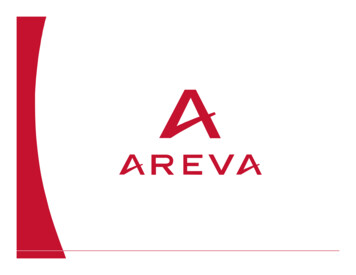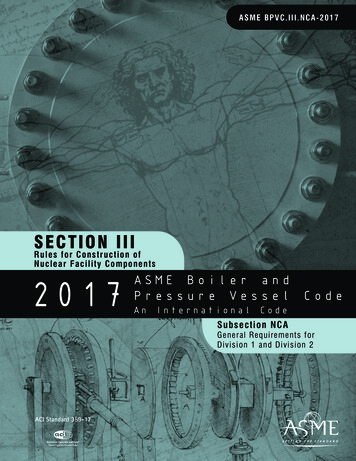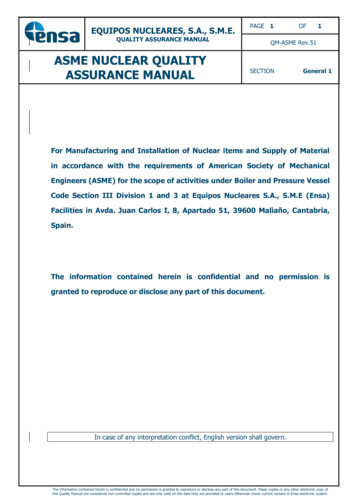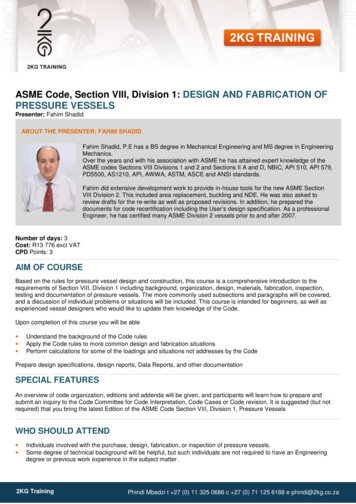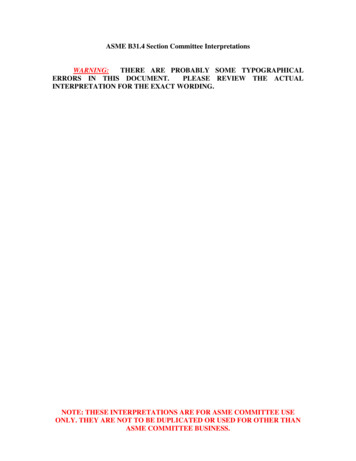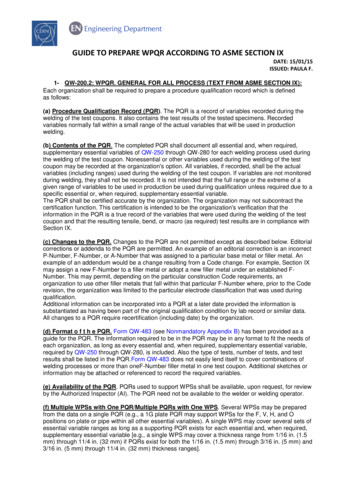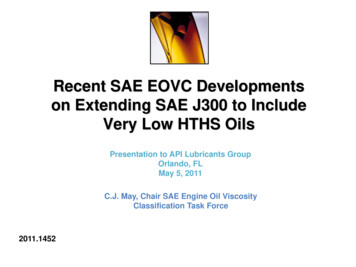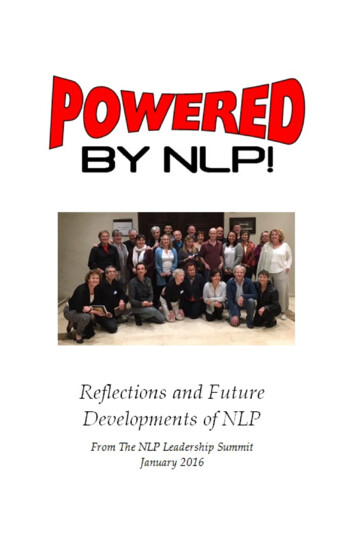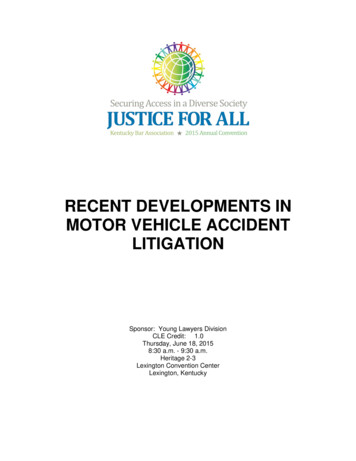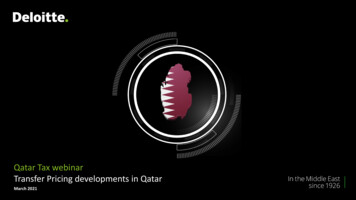
Transcription
1
ASME Section IIINew DevelopmentsRalph S. Hill IIIWestinghouse Consulting EngineerASME Vice President Nuclear Codes and StandardsChair of BPV III for Construction of Nuclear FacilitiesNuclear Codes & Standards WorkshopPrague, Czech RepublicSponsored by ASME and ÚJV Řež
Topics Five (5) Divisions of Section IIISection III, Division 1 InitiativesSection III, Division 2 InitiativesSection III, Division 3 InitiativesSection III, Division 5 InitiativesSummary3
Section III – 5 Divisions (Div)Div 1: Class 1, 2, 3 & MC Components; Supports; CoreSupport Structures; and Class 1 Components inElevated Temperature ServiceDiv 2: Concrete ContainmentsDiv 3: Containments for Transportation and Storage ofSpent Nuclear Fuel and High Level RadioactiveMaterial and WasteDiv 4: Fusion Energy Devices (in development)Div 5: High Temperature Reactors4
Division 1 InitiativesClass 1, 2, 3 & MC Components;Supports; Core Support Structures;and Class 1 Components in ElevatedTemperature Service5
Division 1 Initiatives (1 of 8)ASME commissioned a project under ASMES&T LLC to develop an SMR roadmap Draft report is undergoing peer review Target: issue SMR roadmap by end of June 2014. Implement actionable items – To Be Determined6
Division 1 Initiatives (2 of 8)ASME develops the Nuclear Code of the future with aninitial target publication date of June 2025An early draft vision statement for this objective is:“A simplified Code that recognizes and utilizes modernconstruction methodology, governs the completelifecycle of the component or system, maintainsappropriate margins of safety, invokes performancebased value added requirements and provides separateadministrative and technical requirements.”7
Division 1 Initiatives (2 of 8)ASME develops the Nuclear Code of the futurewith an initial target publication date of June 2025– target dates: Vision and Concept Development – end of CY2015 Content Development – Summer of CY 2024 Governance Development – end of CY 2017 andreaffirmed Spring of CY 20238
Division 1 Initiatives (3 of 8) Establish rules for repair of components thatsupport needs of newly constructed plants likeWatts Bar 2 and new plant construction (withemphasis on those licensed to 10CFR Part 52),including modular construction– BPV III forms a Task Group on Component Repair– Issue Code Cases or revisions to BPV III thatestablish rules for repair of components9
Division 1 Initiatives (4 of 8)Develop rules to allow for construction of largercomponents prior to identification of an Owner Revise NCA-3256(b) to eliminate the restrictionsimposed by that paragraph for construction of itemsprior to Owner involvement. C&S Connect record 13-1783 has been created and thebackground document for this proposed change is outfor review.10
Division 1 Initiatives (5 of 8)Develop Sec. III Appendix for the design andfabrication of high density polyethylene (HDPE)pipe Appendix has been developed is out for ballot at BPVIII (14-1440). Target publication in the 2015 Code. Regulator acceptance via 10CFR50.55a in 2017(tentative, based on regulator schedule).11
Division 1 Initiatives (6 of 8)Update existing Rules for Impactive and ImpulsiveLoads. Develop a proposed code change to update existingrules. Target publish Phase 1 rules in a Code Case by the endof 201512
Division 1 Initiatives (7 of 8)Revise Registered Professional Engineerjurisdictional requirements to eliminate as a barrierto global application of BPV III. June 2014 Code Week – Joint BPV III/TOMC TGreached consensus opinion and approval to prepareCode Revisions for affected standards Target: Code Cases or revisions to BPV III thatimplement consensus opinion approved and publishedby June 201613
Division 1 Initiatives (8 of 8)Simplify the code by eliminating content that isduplicated in various Code books. Completion of two ongoing consolidation activities inSubgroup Component Design:– 10-1381 Consolidation of Design-by-Analysis– 13-932 Consolidation of Design-by-Rule for Vessels Target: publication in the 2017 Edition14
Division 2 InitiativesConcreteContainments15
Division 2 Initiatives (1 of 2)Obtain NRC Endorsement of the 2013 Edition ofSection III, Division 2. The NRC has agreed that Division 2 Regulatory Guideswill be updated and will reference a more recent Editionof the Division 2 Code Target: will be accomplished based on the NRCschedule for updating Reg. Guides.16
Division 2 Initiatives (2 of 2)Develop Rules for beyond design basis accidentsspecifically for the evaluation of impactive andimpulsive loadings. Develop funding for testing of impactive loading effectson concrete containments. Target: obtain funding for Phase I testing by the end of201517
Division 3 InitiativesContainments for Transportationand Storage of Spent NuclearFuel and High Level RadioactiveMaterial and Waste18
Division 3 Initiatives (1 of 3)Achieve U.S. Nuclear Regulatory Commission(NRC) endorsement of Section IIII, Division 3. NRC is completing review of Div 3 and will providereview comments to Division 3 committees fordiscussion and clarification. Target: 2017 Edition has been established forpublishing necessary revisions in order to satisfy NRCreview comments.19
Division 3 Initiatives (2 of 3)Develop Rules for beyond design basis accidentsspecifically for the evaluation of impactive andimpulsive loadings. Develop funding for testing of impactive loading effectson concrete containments. Target: obtain funding for Phase I testing by the end of201520
Division 3 Initiatives (3 of 3)Publish new Subsection WD, construction rules forinternal support structures (or baskets) for use instorage or transportation containments, or both. A draft has been submitted to the BPV III for approval. However, Division 3 General Requirements(Subsection WA) also need revision and final approvalbefore this new subsection can be published. Target: publication in 2017 Edition21
Division 4 InitiativesFusion Energy Devices(in development)22
Division 4 Initiatives (1 of 4)Issuance of ASME III Division 4. Target: publication of first section of fusion codes rulesin 2015 Edition Draft section has been developed that includes differentfusion component types with an attempt to make itcountry technology neutral.23
Division 4 Initiatives (2 of 4)Enhance global membership by establishing globalnetwork of fusion users in Div 4 work groups. Establish 6 new work groups with officers andmembership representing global fusion user base.– There are 15 members of the SG Fusion Energy Devices thatrepresent 6 different countries and many different globalcompanies. Establishment and approval of 6 work groups to be partof the 2015 Edition24
Division 4 Initiatives (3 of 4)Global Involvement of Fusion Users in Committeeactivities. One meeting a year of the SG Fusion Energy Deviceswill be held outside of ASME Code Week and outsideof the USA.– Two meetings were held in 2014 outside of the USA in Chinaand Oxford UK and two meetings were held in 2013 at otherglobal locations.25
Division 4 Initiatives (4 of 4)Develop rules for components that are consideredpart of the pressure boundary and/or structuralintegrity of a fusion system. This is being worked in a Phased Approach using theapproved Division 4 Roadmap. Target: Issuance of first draft of fusion component rulesby the 2015 BPV Edition26
Division 5 InitiativesHigh Temperature Reactors27
Division 5 InitiativesSG-HTR is currently updating their initiative anddevelopment activities. Will review the planning for the 2017 codeedition and beyond 2017 editions in August2014 and provide by August 2014.28
Summary There are significant initiatives in all of the five(5) Section III divisions. We need and welcome your participation andcontributions. Please contact me here or later athillr@ASME.org29
Section III –5 Divisions (Div) Div 1: Class 1, 2, 3 & MC Components; Supports; Core Support Structures; and Class 1 Components in Elevated Temperature Service Div 2: Concrete Containments Div 3: Containments for Transportation and Storage of Spent Nuclear Fuel and High Level Radioactive Material and Waste Div 4: Fusion Energy Devices (in development)
